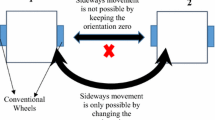Abstract
Admittance control is used mainly for human–robot interaction. It transforms forces and torques to the desired position and orientation of the end effector. When the admittance control is in the task space, it needs the Jacobian matrix, while in the joint space, it requires the inverse kinematics. This paper modifies the admittance control using only the orientation components of the end-effector to avoid the calculation of the inverse kinematics and the Jacobian matrix. We use geometric properties, adaptive control and sliding mode control to approximate them. The stability of those controllers is proven. Experiments are presented in real time with a 2-DOF pan and tilt robot and a 4-DOF exoskeleton. The results of the experiment show the effectiveness of the proposed controllers.












Similar content being viewed by others
Notes
Joint space is defined by a vector whose components are the translational and angular displacements of each joint of a robotic link.
Task space (or Cartesian space) is defined by the position and orientation of the end effector of a robot.
References
Dimeas F, Aspragathos N (2016) Online stability in human–robot cooperations with admittance control. IEEE Trans Haptics 9(2):267–278
Ficuciello F, Villani L, Siciliano B (2015) Variable impedance control of redundant manipulators for intuitive human–robot physical interaction. IEEE Trans Robot 31(4):850–863
Bonitz RG, Hsia TC (1996) Internal force-based impedance control for cooperating manipulators. IEEE Trans Robot Autom 12(1):78–89
Abdossalami A, Sirouspour S (2008) Adaptive control of haptic interaction with impedance and admittance type virtual environments. In: Symposium on haptic interfaces for virtual environments and teleoperator systems, pp 145–152
Kazerooni H, Herm MG (1994) The dynamics and control of a haptic interface device. IEEE Trans Robot Autom 10(4):453–464
Garrido J (2015) Aprendizaje por demostración en el espacio articular para el seguimiento de trayectorias aplicado en un exoesqueleto de 4 grados de libertad. Centro de Investigación y Estudios Avanzados del Instituto Politécnico Nacional, México
Dohring M, Newman W (2003) The passivity of natural admittance control implementations. In: IEEE international conference on robotics and automation, pp 371–376
Yu W, Rosen J, Li X (2011) PID admittance control for an upper limb exoskeleton. In: American control conference, pp 1124–1129
Hogan N (1985) Impedance control: an approach to manipulation. J Dyn Syst Measurement Control 107:1–24
Yu W, Carmona R, Li X (2013) Neural PID admittance control of a robot. In: American control conference, pp 4963–4968
Kang SH, Jin M, Chang PH (2009) A solution to the accuracy/robustness dilemma in impedance control. IEEE ASME Trans Mechatron 14:182–194
Chih M, Huang AC (2004) Adpative impedance control of robot manipulators based on function approximation technique, robotica. Cambridge University Press, Cambridge, pp 395–403
Lu WS, Meng QH (1991) Impedance control with adaptation for robotic manipulators. IEEE Trans Robot Autom 7(3):408–415
Kelly R, Carelli R, Amestegui M, Ortega R (1989) On adaptive impedance control of robots manipulators. IEEE Robot Autom 1:572–577
Tee KP, Yan R, Li H (2010) Adaptive admittance control of a robot manipulator under task space constraint. In: IEEE international conference on robotics and automation, pp 5181–5186
Singh SK, Popa DO (1995) An analysis of some fundamental problems in adaptive control of force and impedance behavior: theory and experiments. IEEE Trans Robot Autom 11(6):912–921
Ferreti G, Magnani GA, Rocco P (2004) Impedance control for elastic joints industrial manipulators. IEEE Trans Robot Autom 20(3):488–498
Irawan A, Moktadir M, Tan YY (2015) PD-FLC with admittance control for hexapod robot’s leg positioning on seabed. In: IEEE American control conference
Kiguchi K, Tanaka T, Fukuda T (2004) Nuero-fuzzy control of a robotic exoskeleton with EMG signals. IEEE Trans Fuzzy Syst 12(4):481–490
Mohammadi H, Richter H (2015) Robust tracking/impedance control: application to prosthetics. In: American control conference, pp 2673–2678
Yu W, Rosen J (2010) A novel linear PID controller for an upper limb exoskeleton. In: 49th IEEE conference on decision and control, pp 3548–3553
Tufail M, de Silva CW (2014) Impedance control schemes for bilateral teleoperation. In: International conference on computer science and education, pp 44–49
Perrusquía A, Yu W, Soria A, Lozano R (2017) Stable admittance control without inverse kinematics. In: 20th IFAC world congress (IFAC2017), Toulose
Ramírez D, Arturo O, Parra Vega V, Díaz Montiel MG, Pozas Cardenas MJ, Hernández Gómez RA (2008) Cartesian sliding PD control of robots manipulators for tracking in finite time: theory and experiments. In: DAAAM international scientific book, chapter 23, pp 257–272
Kelly R, Santibáñez V (2003) Control de Movimiento de Robots Manipuladores. Pearson Prentice Hall, Upper Saddle River
Spong MW, Hutchinson S, Vidyasagar M (2004) Robot dynamics and control. Wiley, Eglinton
Perrusquía A, Yu W (2019) Task space human–robot interaction using angular velocity Jacobian. In: 2019 international symposium on medical robotics (ISMR)
Roy S, Edan Y (2018) Investigating joint-action in short-cycle repetitive handover tasks: the role of giver versus receiver and its implications for human–robot collaborative system design. Int J Social Robot. https://doi.org/10.1007/s12369-017-0424-9
Someshwar R, Kerner Y (2013) Optimization of waiting time in HR coordination. In: 2013 IEEE international conference on systems, man, and cybernetics (SMC13), pp 1918–1923
Author information
Authors and Affiliations
Corresponding author
Ethics declarations
Conflict of interest
The authors declare that they have no conflict of interest.
Additional information
Publisher's Note
Springer Nature remains neutral with regard to jurisdictional claims in published maps and institutional affiliations.
Rights and permissions
About this article
Cite this article
Yu, W., Perrusquía, A. Simplified Stable Admittance Control Using End-Effector Orientations. Int J of Soc Robotics 12, 1061–1073 (2020). https://doi.org/10.1007/s12369-019-00579-y
Accepted:
Published:
Issue Date:
DOI: https://doi.org/10.1007/s12369-019-00579-y



